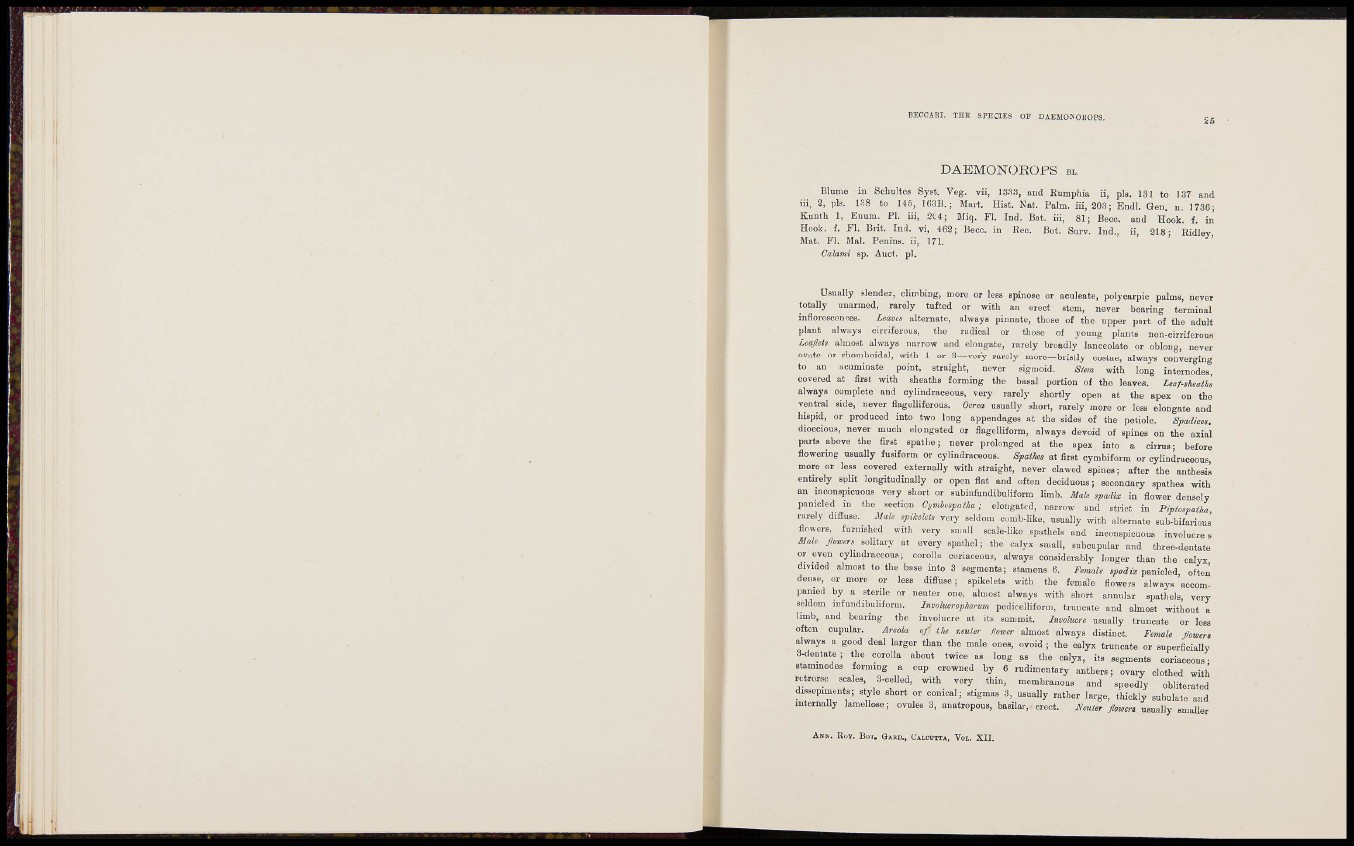
BECCAEI. THE SPECIES OP DAEMOKOliOPS.
DAEMONOROPS BL.
Blume in Schultes gyst. Veg. vii, 1333, and Enmphia ii, pis. 131 to 137 and
iii, 2, pis. 138 to 146, 163B. ; Mart. Hist. Nat. Palm, iii, 2 0 3 ; Endl. Gen. u. 1738;
Kunth 1, Ennm. PI. iii, 204; Miq. H. Ind. Bat. iii, 81; Becc. and Hook. f. in
Hook. f. f l . Brit. Ind. vi, 462; Beco. in Rec. Bot. Sm-v. Ind., ii, 218- Ridley
Mat. Fl. Mai. Ponins. ii, 171.
sp. Auct. pi.
Usually Blender, climbing, more or less spinose or aculeate, polycarpio palms, neyer
totally unarmed, rarely tufted or with an erect stem, never bearing terminal
inflorescences. Lima alternate, always pinnate, those of the upper part of the adult
plant always cirriferous, the radical or those of young plants non-ciriiferous
LeqlUb almost always narrow and elongate, rarely broadly lanceolate or oblong, never
ovale or rhomboidal, with 1 or 3 - v e r y rarely m o r e - b r i s t l y costae, always converging
to an acuminate point, straight, never sigmoid. Stem with long internodes
covered at first with sheaths forming the basal portion of the leaves. Liaf-aheath
always complete and oylindraceous, very rarely shortly open at the apex on the
ventral side, never flagelliferous. Oerea usually short, rarely more or jess elongate and
hispid, or produced into two long appendages at the sides of the petiole. Sfmdhts.
dioecious, never much elongated or flagelliform, always devoid of spines on the axial
parts above the first spathe; never prolonged at the apex into a cirrus; before
flowering usually fusiform or cylindraceous. Spathes at flrst cymbiform or cylindraceous
more or less covered externally with straight, never clawed spines; after the anthosis
entirely split longitudinally or open flat and often deciduous; secondary spathes with
an inconspicuous very short or subinfundibuliform limb. Main tpadix in flower densely
panicled in the section Ctmlospaiha; elongated, narrow and strict in Pipiospaiha
rarely diffuse. MaU spikeleU very seldom comb-like, usually with alternate sub-bifarious
floxers, furnished with very sn.all scale-IIke spathels and inconspicuous involucres
Mah fowen solitary at every spalhel; the calyx small, subcupular and three-dentate
or even cylindraceou.; corolla coriaceous, always considerably longer than the calyx
divided almost to the base into 3 segments; stamens 6. Fcmah tp.iix panicled, often
dense, or more or less diffuse ; splkelets with the female flowers always accompanied
by a sterde or neuter one, almost always with short annular spathels very
seldom infundibuliform. Involucroflmum pedicelliform, truncate and almost without a
hmb, and bearing the involucre at its summit. Imolucre usually truncate or less
often cupular. Areola o/ i/ie leuta- flov>er almost always distinct. Female Jlowen
always a good deal larger than the male ones, ovoid ; the calyx truncate or superficially
3-dontate; the corolla about twice a, long as the calyx, its segments coriaceousstaminoies
forming a cup crowned by 6 rudimentary anthers; ovary clothed with
rotrorse scales, 3-celled, with very thin, membranous and speedly obliterated
dissepiments; style short or conical; stigmas 3, usually rather large, thickly subulate and
internally lamollose; ovules 3, anatropous, basilar, erect. A^euter Jlmen usually smaller
ANN. RUY. BOT, QAKD., UALCurrA, VOL. X I I.